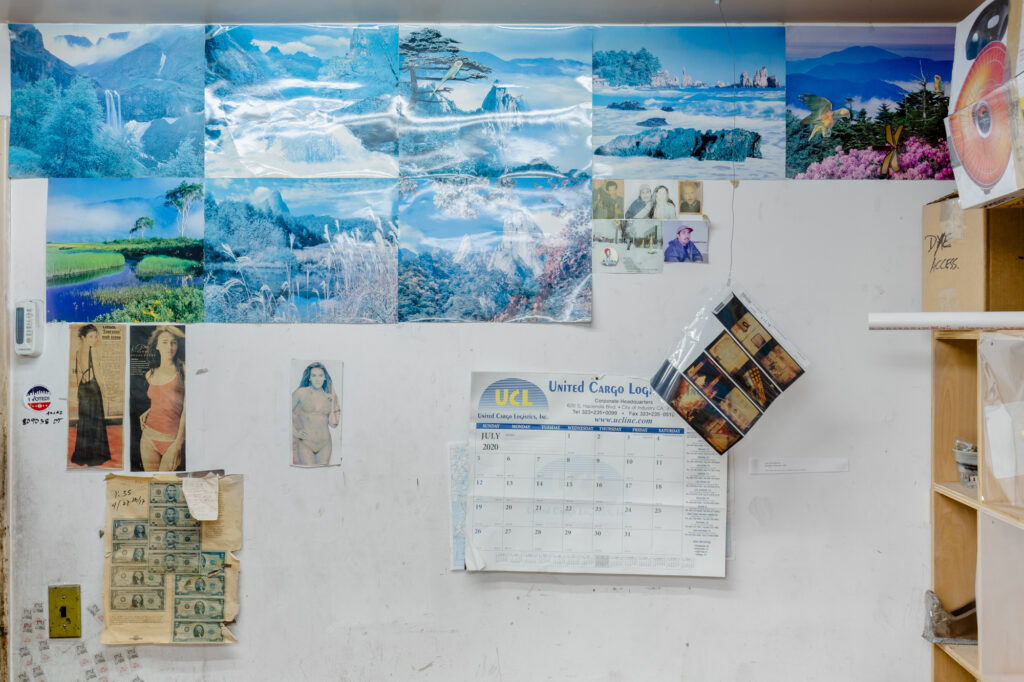

Ari-Duong Nguyen, Do Tuong Linh, Lily Jue Sheng, Serena Chang
Means of Production is an independent project by Lunch Hour Collective (Do Tuong Linh, Lily Jue Sheng, Serena Chang), gathering a multidisciplinary cohort of eighty artists to exhibit and enact happenings inside the Sheerly Touch-Ya/Shisanwu LLC warehouse in Queens. The exhibition addressed questions around labor from the perspective of contemporary artists, through a generous offering of aesthetic inquiries that challenge how we evaluate our living, working and being in the world. I interview the members on the making of Means of Production and the rationales that delineate their collective practice.
Ari Can you speak more about the beginning of the exhibition? I read that there was an open call; I’m curious what narrative around art and labor — your Collective’s main interest — was included?
Linh Since the beginning of 2023, we’ve been exploring the idea of putting together a show at the warehouse, engaging in discussions from our diverse perspectives as curators, art writers, artists and fabricators. Positioned in New York City — the epicenter of the global art world — this shared environment became the catalyst for our concept.
Lily Our outreach was a bit different from an open call, but an offshoot of how those are run. Considering the circumstances of how we hadn’t worked together before, and that we wanted to experiment with fundraising on our own and mount this exhibition regardless of how much money came in, I felt it was reasonable to do outreach to people who were either familiar with the context of the warehouse or with one of us as artists and/or cultural workers. Speaking for myself, I think of the collective and show as an unorthodox kind of workers’ inquiry.
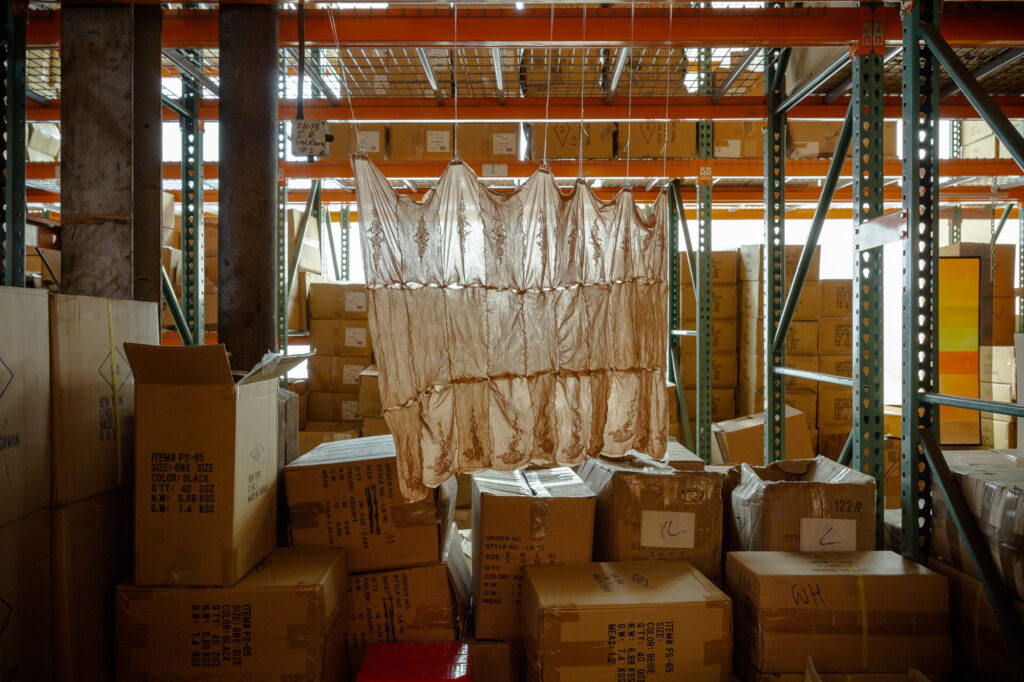
Photo credit: Daniel Terna, exhibition documentation of Means of Production (Catherine Lie’s In the company of my family, 2024, sheerly touch-ya hosiery, nylon filament)
Ari How was the selection and exhibition design informed by both your intentions and the particularities of the space?
Lily We wanted to counter the art market models often based on merit, aesthetic cohesion, or an artist’s individual practice and the social capital surrounding those priorities. It meant committing to many artists because we didn’t reject any proposals, but it was critical to work at the scale that we did. The way this show was installed in an active workspace made it so our art vs. work was not as compartmentalized nor confined to the often unspoken rules around what or where or who gets assigned cultural significance.
Serena In the exhibition prompt, we offered deadstock hosiery styles and packaging as available materials for artists to work with. So that became a recurring theme in many artworks, which tied different installations together as they were spread out through the warehouse, nested between hosiery boxes.
Linh It was striking to see that many participating artists work odd jobs within the art industry—photographers, fabricators, artist’s assistants, and the like. They exemplify the structure and hierarchy of the art world. I’m also drawn to artists with roots in fashion and textile, noting an inherent intergenerational connection, akin to Serena and her father’s ties to the hosiery industry, which mirrors the overlap between the art and fashion worlds. Many artists in the show share a similar heritage, shaped by their families’ migrant backgrounds and ties to these industries.
Lily We countered what I see as “overproduced art” in biennials and art fairs. We developed a framework that was more serendipitous than extensively researched, which I call “three-second curating,” because we’re all working and doing this voluntarily in our spare time. When late spring hit, we had to power through scheduling the artists to come in, install and determine the exhibition layout. Many decisions were made quickly, which added a charming energy to Means of Production, since this project was simultaneously laborious, but not necessarily overly produced nor mapped into a sterile environment.
Serena Without any funding, you have to just make it work. There was a spirit that everyone could feel that was inspiring and exciting.
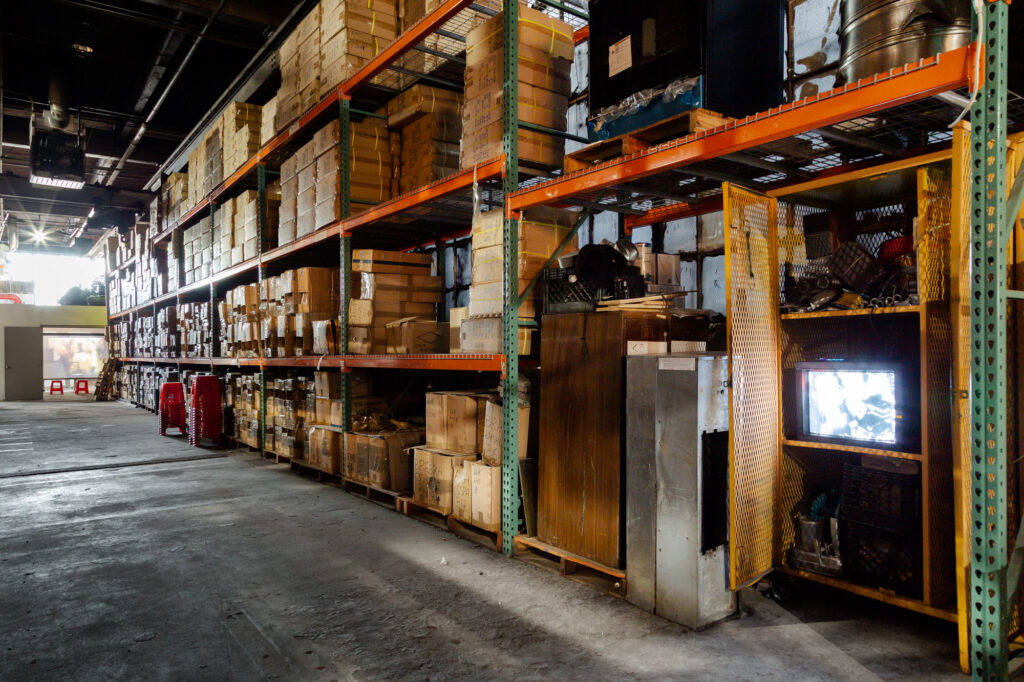
Photo credit: Daniel Terna, exhibition documentation of Means of Production, hosiery aisle with Yuula Benivolski’s You May Laugh at Me a Little playing in the projection room, and Sierra Pettengill’s Fur Strike (Family Album) playing on the CRT monitor
“Play, in relation to experimentation and embracing unknown paths, is really all we’ve got under capitalism. From a collective or organizational framework, we’re often trying to move out from underneath these systemic inequities that we keep reproducing.”
Ari That DIY quality also results in a lot of playfulness. What do you see as a connection between play and labor relations, as work is so often pitted against leisure?
Serena The architecture of the hosiery warehousing with rows and rows of pallet rack shelving was significant to how the art engaged with the space. How specific spaces and moments could be playfully created within it inspired a lot of artists.
Linh Engaging physically in the show — from cooking for our fundraising hot pot, to carrying and setting up works by hand — was refreshing. It allowed me to step away from the often abstract processes of knowledge creation and production typically associated with curators and art writers, making the process both enjoyable and grounding.
Lily Play, in relation to experimentation and embracing unknown paths, is really all we’ve got under capitalism. From a collective or organizational framework, we’re often trying to move out from underneath these systemic inequities that we keep reproducing. The most liberatory framework I’m often able to develop is typically through these temporary pockets of play and leisure amongst each other, because we haven’t figured out how to implement more sustainable systems within society at large.
Ari I’m also wondering if you can expand on the intention to have art objects being physically adjacent to mass-produced, sellable goods, or alternatively, performative art objects next to inventory which are objects-in-waiting?
Serena Naturally, they performed as frames, as plinths, as housing for all the artworks. The idea was to embed these installations into the working landscape. The building’s set-up really invited that.
Lily The question of art objects and mass-produced objects relate to conversations Serena and I had about art and labor over the years before we proactively worked on this show. The enmeshment of art and labor is very literal in this space. Serena’s family immigrated to the U.S. and started a small business in hosiery production, which is arguably part of the garment industry. This trajectory is what registers with so many immigrant journeys of wanting to achieve the American dream. That term, “American Dream,” was written in our original call text. The second generation often works toward higher education, status, and/or proximity to cultural capital, as a result of being raised in America. Sheerly Touch-Ya (the family’s business) and Shisanwu LLC (Serena and Aric’s sculpture fabrication business) exist side-by-side, operating with different generational values, culture, and modes of production. However, is the next generation’s labor conditions any better?
We are drilled to accept intellectual values associated with art, as implying privilege and distinction from mass production and wage work. But the question we need to ask in the context of the exhibition is whether the distinctions serve to improve or de-alienate our labor conditions.
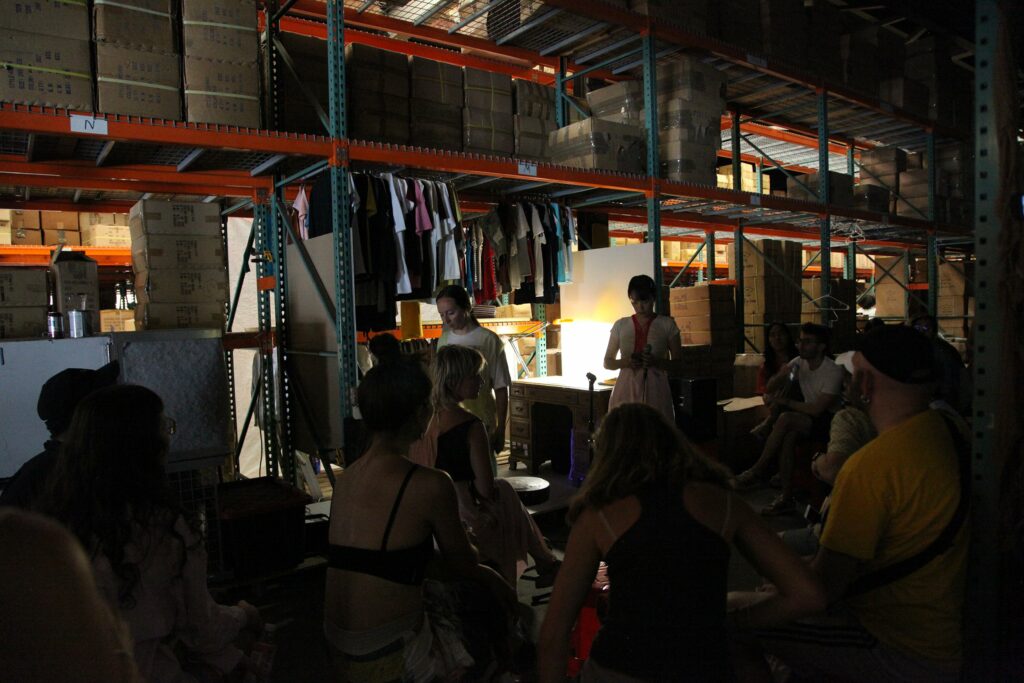
Photo credit: Lane Lang, documentation of Means of Production closing event Stockings and Sabotage, a runway show of Use Value garments and conversation with R.H. Lossin on the Luddites presented by Shanzhai Lyric
Ari Thank you for sharing that insight from your conversations. And to speak of the participating artists and the sheer size of your exhibition, how does the idea of collectivity play a role in Means of Production?
Linh The last few years saw this hype around collectives, like with Documenta and Ruangrupa. Yes, we work together, the three of us come from different backgrounds, and we want to support each other, but it doesn’t mean that we could be the voice to speak for one another. I come from Vietnam where this sense of collectivity and community gets used in many contexts for different projects. There’s skepticism around that too, relating to communism and the way people arrange for collectivity to work for a certain same ideal.
Same goes for the artists that we work with, or the way we organize events. We open up space for happenings, for artists to have space to create, for people to have the space to discuss and engage. But we don’t necessarily try to direct them. The show just finished and we’re still in the process of continuing to think about it, definitely not having, say, a manifesto or a big statement about what it means. People have asked about what’s next. I think everything can be open.
Serena I was surprised at the enthusiasm and genuine engagement from contributors. There were 80 participants including artists, speakers, filmmakers, and performers. Since labor conditions are increasingly unsustainable in the contemporary landscape of work, the prompt was relatable to many.
Lily Because everything is next to the architecture and work equipment or close to another artist’s work, in various spatial proximities to each other, it’s not conducive to dedicate your attention to a single authorial voice. That sense of collectivity manifested in conceptual, material, and arguably political ways.
As Linh mentioned, at this scale of work, with our different schedules, it’s hard to come to every decision unanimously. We did individually spearhead specific ideas or programs based on our skill sets. Still, our banding together toward a vision will speak to art and labor very distinct from how we would do things as individuals, and it naturally produces tension. The tensions of success, conflict, and moving through problems as a collective and in cultural labor… I learned so much from this show.
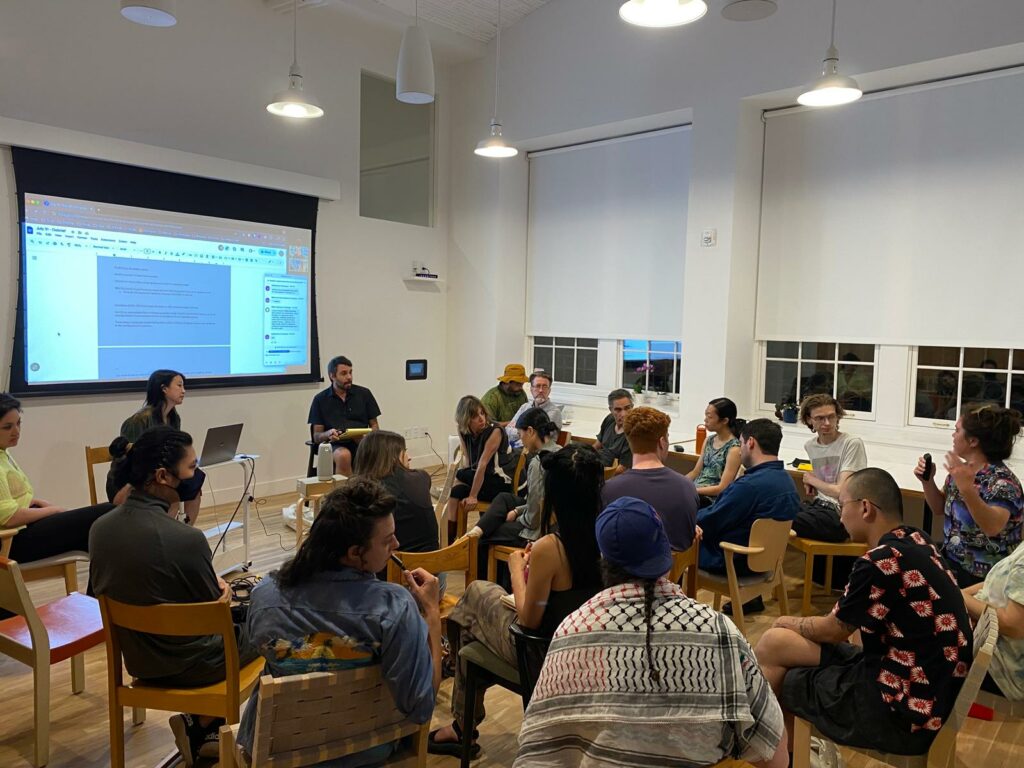
Photo Credit: Serena Chang, documentation from the hybrid art workers’ general assembly meeting at the Whitney ISP studio building
Ari How has your Collective connected the present state of artistic labor in NYC with the contemporary global labor relations?
Serena My background is sculpture fabrication, and I frequently think about labor, how things are made and valued. There’s often a lack of understanding of what it means to produce things, especially in our globalized economy where you can just order something on Amazon and it comes the next day. There is an invisible infrastructure that supports our capitalist society.
Linh Labor also has a lot to do with power structures. New York, in a way, is still the center of the art world. Talking about it is also being critical of it, given that New York or America still holds imperial power, especially through media.
We pulled it together with such a limited amount of time together amongst other responsibilities. Not just us three, but everyone in the show, because New York artists are hustling multiple jobs just to survive to make art, which might be very different elsewhere. This relation between art, labor and capitalism is most amplified here. We’re still thinking about and digesting this, us and the artists in the show, reflecting on what could happen. What I think to be most rewarding and inspiring is the kind of connection that happens from this, leading to inspiration or potential collaborations.

Photo Credit: Daniel Terna, exhibition documentation of Means of Production (medium format stills from Lily’s film Heritage Architecture, 2024) against faded images left from different employees in the hosiery packing room
Do Tuong Linh, Lily Jue Sheng, Serena Chang of Lunch Hour Collective
Tallulah Schwartz, Daniel Terna, Lane Lang

